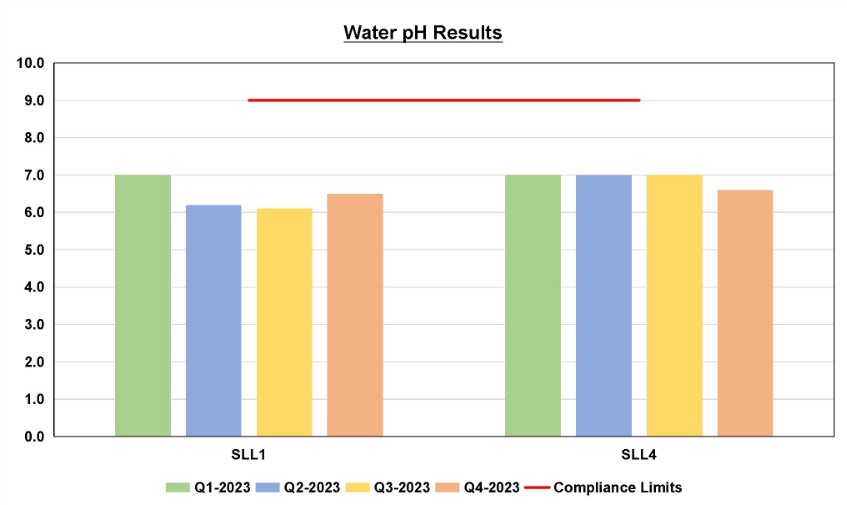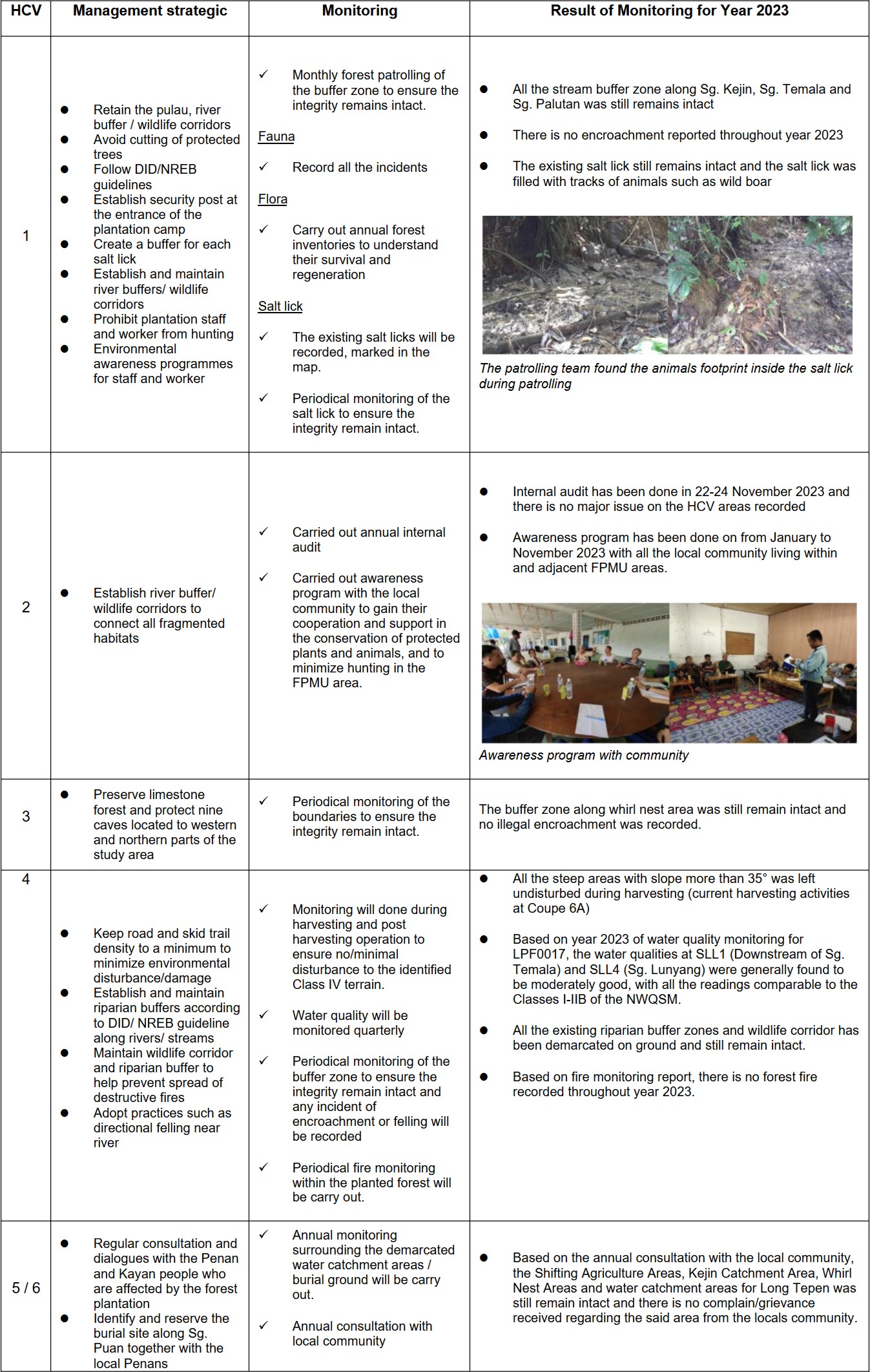SHIN YANG FORESTRY SDN. BHD.
PUBLIC SUMMARY
FOREST PLANTATION MANAGEMENT PLAN
FOR
LPF/0017 – KEJIN FPMU
(VERSION 08-revised on August 2024)
1. INTRODUCTION OF KEJIN FPMU
Figure 1.0: Location of LPF/0017-Kejin FPMU
LPF/0017-Kejin Forest Plantation Management Unit (FPMU) is part of Long Lama Estate which has been granted under License for Planted Forest LPF/0017 by the Director of Forest, Sarawak for a period of 60 years from 19 November 1999 to 18 November 2059, managed by Shin Yang Forestry Sdn. Bhd. Kejin FPMU is located in Long Lama, east bank of Batang Baram in Baram District, Marudi, about 45km south of Marudi town. The FPMU is covering 28,093.35ha which is part of LPF/0017.
Most of the area is heavily logged over forest under logging license T/0370 and T/0191. Land use of the areas adjacent to the FPMU is mostly Oil Palm Plantations and Timber logging licenses. About 41% from the total FPMU area is plantable, while the balance of 59% is reserved in situ for shifting agriculture, water catchment, whirl bird nest area, stream buffer zone/biological corridor and etc. (refer Table 1.0)
Table 1.0: Details of Kejin FPMU Areas
2. POLICY OF COMMITMENT
3. MANAGEMENT OBJECTIVE
The management objective of the plantation is to enable a continuous supply of timber for downstream processing activities (plywood, veneer and particle board) especially for Shin Yang Group of wood processing plants. There is also the global sentiment to source for timber from planted forest instead of from natural forests. Planted forests have the advantage of planned and timed production, uniformity of logs and automation in the processing plants. They will also help to reduce harvesting pressure on the remaining natural forests.
In order to achieve the balancing between environmental, social and economic. The distinctive objectives of forest management are broken down as below:
-
Optimum utilization of forest resources while ensuring ecological function
-
Regulation of harvest on a sustained yield basis
-
To reduce environmental impacts
-
To promote the restoration of degraded forest, protection, and conservation of natural forest within FMPU area
-
To maintain or enhance the long term social and economic well-being of workers and local communities
4. MANAGEMENT SYSTEM
The forest plantation management is committed to Sustainable Forest Management (SFM) which is the process of managing forest plantation site to achieve one or more clearly specified objectives of management with regard to the production of a continuous flow of desired forest products and services without undue reduction in its inherent values and future productivity and without undue undesirable effects on the physical and social environment
5. FOREST RESOURCE DESCRIPTION
5.1 Geology Soil
The dominant soils are the Merit soils which make up about 49.31% of the total area and the Kapit soils which cover another 30.36% of the area. The Bemang/ Bekenu soils which are confined to the riverine areas make up 8.54% while the Merit/ Kapit soils takes up 3.93% of the site. The balance of 7.86% is made up of the Bekenu/ Merit soils, Kapit/ Silantek soils, and Meluan soils. The site is therefore dominated by the Red Yellow Podozolic soils of the Merit series and skeletal soils of Kapit series.
5.2 Growing Timber Stock
The forest in licence area is a hill mixed Dipterocarp forest that has been logged over and developed for agricultural activities. Due to such activities, there are only limited large diameter trees which is too little for harvesting or has no economic value, therefore the company decided to plant medium-sized fast-growing trees with mix of both exotic and indigenous species with an average cropping cycle of 7-10 years, or more for specific species.
5.3 Non-timber Growing Stock
Non-timber product such as rattan, bamboo, and wild vegetable and fruits are still available at Kejin FPMU. These non-timber products are reserved for local community use.
6. ENVIRONMENTAL LIMITATION
The FPMU site is undulating to hilly condition with slope of 6° to more than 30°. This terrain factor causes difficulty to access some area during the wet season and the steep terrain has high potential to soil erosion during heavy rain. Average rainy days are about 169 days per year and this limitation affects our operation.
7. LAND USE
The FPMU site is intensively logged over forests of the former hill dipterocarp forest. Active logging is still going on in the project site. There are evidences of localized shifting cultivation along logging roads by previous logging workers.
Development of the plantation involves several stages such as project site investigation, nursery establishment, plantation buildings and amenities, land preparation, construction of infrastructure, field establishment, maintenance and abandonment and replanting.
8. SOCIO-ECONOMIC CONDITION
Based on the SIA report, There are 9 longhouses and one (1) township located within and adjacent FPMU areas with total population 8,779 people and 988 doors.
The local communities staying within and adjacent the LPF/0017 consist of the Kenyah, Penan and Kayan. There are 3 settlements and one township, Long Lama located within boundary and the others 6 settlements located adjacent to the FPMU boundary. The basic settlements profiles are given in Table 2.0 and Figure 2.0. Except for Uma Akeh which is Kenyah, Long Tepen and Long Lunyim are of Penan origin, the rest of the settlements are Kayan.
Most of the local communities practices distinctive social-cultural systems which stems on their native culture which was passed down from previous generations. Most of them worked in the logging camp and work as farmer. They speak their own language, practice distinctive social-cultural systems and carry out various economic activities.
Table 2.0: Demography of the Settlements within the FPMU Boundary
About 60% of the local people are farmers with the main crops planted are hill padi while the rest sort works outside such as in the nearby logging camps. All the longhouses also receive some form of farm assistant from the Department of Agriculture. Livestock such as pig and chicken are commonly raised in small scale.
There is no direct electricity and reliable water supplies supply to the settlements. All the longhouses use their own generator for electricity and used gravity pipe water for their water sources. Every door has at least a large water storage tank and some of the tanks are supplied by the Medical Department.
The development of the plantation is expected to generate long term benefits such as employment opportunities and business for the local people especially people in the Baram area. Most of them used to work in logging camps and as farmer. Such local people will be given priority to work for the plantation if they are willing based on their qualification, performance and expertise. The income earned from working in the project area will further supplement the family income. It will also help upgrading the quality of life. Upon completion and production, the plantation will contribute towards enhancing the State’s economy.
 Figure 2.0: Location of the longhouses within Kejin FPMU
Figure 2.0: Location of the longhouses within Kejin FPMU
9. PLANTATION ESTABLISHMENT
9.1 Choice Of Species
The FPMU are established with a mix of trees species both exotic and indigenous species as listed in Table 2.3. The predominant species to be established are Acacia mangium and Albizia falcataria. Minor species include Hevea brasiliensis and Eucalyptus spp. The latter will be established on a small scale of trial basis and will be closely monitored by the Company. If proven successful to meet the Company’s needs in short rotation its establishment will be undertaken on a larger scale. Currently, seeds of the major species being procured from Indonesia.
9.2 Nursery Practices
Nursery practice has been standardized after repeated research, and to be applied to the various species. The annual production targets is set based on the planting target plus allowance for nursery mortality, culling rejects, and mortality during transit and after planting in the field.
9.3 Site Preparation
The company is using both manual and mechanical site preparation after selection of suitable sites that exclude steep terrain, HCVs, riparian buffer zones and other protected areas. Minimum slash and burn method also will be applied in a minimum scale with prior permission from Natural Resource and Environment Board (NREB) to control the weeds and green debris. Burning will enhance initial growth rates of the planted trees through the release of nutrients to soil.
10. SILVILCULTURE
10.1 Thinning
Thinning is carried out when canopy competition occurs between trees or for dense site planting by using chainsaw and slasher (parang) to reduce damage to the remaining crop during the felling process. All the abnormal trees whether large or small, inferior trees, branching, forking, unhealthy, disease, multiple stem and slant will be remove.
10.2 Pest And Disease Control
The control of pest and disease is applied for both Nursery and Planting site by using physical and chemical control method.
10.3 Weed Control
Weed and low shrubs which are part or the indigenous ground covers will be slashed back at regular intervals during the initial 3 month of after planting because some species do not tolerate well competition from weeds.
11. HARVESTING PLAN
11.1 Harvesting Operation Prescription
11.1.1 Cutting Rules
The FPMU may fell any planted species of trees which are not prohibited by the Forest Rules and Wildlife Protection Ordinance. Permanent waterways with continuous flow of water throughout the year will be protected by a buffer zone (width of buffer zone is depend on the width of the stream) on both bank of the river and no activities will be permitted in this areas. . Reduce impact logging procedure – The management of forest plantation takes cognizance of the “Reduce Impact Logging, Guidelines/Procedures for Ground Based Harvesting System Using Tractor” applicable to its harvest operation.
11.1.2 Cutting Limit
The downstream processing mill for plywood and veneer is equipped with the latest technology which is enables to peel up to very small logs. Therefore, the company is proposing cutting limit above 10cm at diameter breast high (DBH).
11.1.3 Harvesting System
Harvesting system engaged are RIL and Cable Yarding system to reduce impact especially to the soil and water value, and minimize damage to the residual stand. As fast growing pioneer species need a full light condition for its good growth, that is different from natural tropical tree species, clear felling system will be applied. Protected areas such as Terrain Class IV and Riparian Buffer Zone are strictly prohibited and protected from any disturbance activities.
11.2 Period Of Harvesting
Based on the present research data available from PSPs and proposed diameter cutting limit (minimum 10cm DBH), the growth rates and rotation length for harvesting will be commenced at 10 years after planting in normal case.
11.3 Annual Allowable Cut (AAC)
The allowable cut is based on area control, in accordance with the approved General Harvesting Plan (GP) of the licensed area. The Annual Cutting Area (ACA) is 727.57ha/year.
12. MONITORING OF FOREST GROWTH AND DYNAMIC
12.1 Establishment of Permanent Sample Plots (PSPs)
Proper yield plots have been set up to monitor performance of trees, growth rate of the planted forest and yield of all forest products harvested so that useful data could be procured for estimates of stocking size, quality and stand volume of the plantation. The location of each plot is randomly chosen within the FPMU area and will be measured annually. Pest and disease information is also collected at the time of assessment.
13. ENVIRONMENTAL SAFEGUARD
13.1 Environmental Impact Assessment (EIA) Report
The Environmental Impact Assessment report for the LPF0017 forest Plantation "Environmental Impact Assessment " was approved by NREB Sarawak [(9) NREB/6-11/78 dated 7th June 2000].
13.2 Environmental Compliance Audit (ECA)
The ECA is to make sure licence holder comply with the Term and Condition written in the EIA Report. The Internal ECA will be carry out twice a year by our Internal Auditor registered under NREB and External ECA is carry out once a year by the External Auditor registered under NREB.
13.3 Environmental Monitoring Report (EMR)
The environmental monitoring and review is done by consultancy company quarterly. The monitoring includes water course quality monitoring. The report is submitted to the NREB quarterly.
13.4 NREB Verification and Inspection Visit of The FPMU
The NREB regularly carries out routine environmental inspection on the compliance to the Terms and Conditions of the EIA Report Approval document for the project area.
13.5 Patrolling by FPMU Holder
FPMU holder has been develop patrolling schedule to ensure the protected and HCV areas is remains intact, control encroachment, fire monitoring and to prevent/control unauthorized activities in forest plantation areas.
14. IDENTIFICATION AND PROTECTION OF RARE, THREATENED AND ENDANGERED SPECIES
The guidelines used for identification and protection of ERT species of forest flora and fauna including features of special of special biological interest area:
-
Wildlife Protection Ordinance 1998
-
Sarawak Plant Red List
-
A Master Plan for Wildlife in Sarawak 1996
-
HCVF Toolkit for Malaysia
-
OOrang Utan Strategic and Action Plan
-
The IUCN Red List of Threatened Species at www.iucnredlist.org
Sign boards has been prepared and installed at strategic locations. The entry to FPMU area shall be limited to the unauthorized person. A schedule for monthly patrol for the year has been developed to control fire, hunting, fishing and collecting activities in the forest plantation areas./p>
Signage detailing the Director of Forest Circular 6/99 have been erected in front of the entrance detailing 4 items:
-
Employees of the Timber Companies are not to hunt in the licensed areas while they are in the employ of the company.
-
Company vehicles are not to be used for hunting or for carrying meat of wild animals.
-
Selling of wild animals or meat of wild animals is not allowed in the licensed area.
-
Feeder roads are to be closed after the final block inspection to prevent further entry of vehicles.
15. HIGH CONSERVATION VALUE (HCVs)
HCV 1.1 was not present in plantation area. There are signs of Critically Endangered (CR), Endangered (EN) or Vulnerable (VU) flora and fauna (HCV 1.2 present) observed during the assessment. There are 3 endemic fauna species and 10 endemic flora species in the study sites (HCV 1.3). Areas for critical temporal use were also identified to be present (HCV 1.4).
Although the forest landscape within the study areas has been fragmented by previous logging and plantation development activities, good forest for species diversity, animal refuges and catchment protection, etc. are still available (HCV 2). The limestone forest which located at western and northern parts of the Study Area has been reserved by the Licensee for conservation purpose (HCV3). The ecological values had been identified for:
-
safeguarding watersheds such as buffer zones (HCV 4.1),
-
controlling soil erosion such as terrain IV within coupe 5A (HCV 4.2) and
-
destructive fires (HCV 4.3)
The natural resource in proposed conservation areas will cater to the needs of local communities. The burial grounds along Sg. Puan are present (HCV 5& 6).
To ensure the long-term sustainability of the HCVs, Kejin FPMU had implemented the management and monitoring as below;
Table 3.0: Management and Monitoring of the HCVs
16. RESULT OF FOREST MONITORING AND ASSESSMENT
16.1 Yield Of All Forest Products Harvested
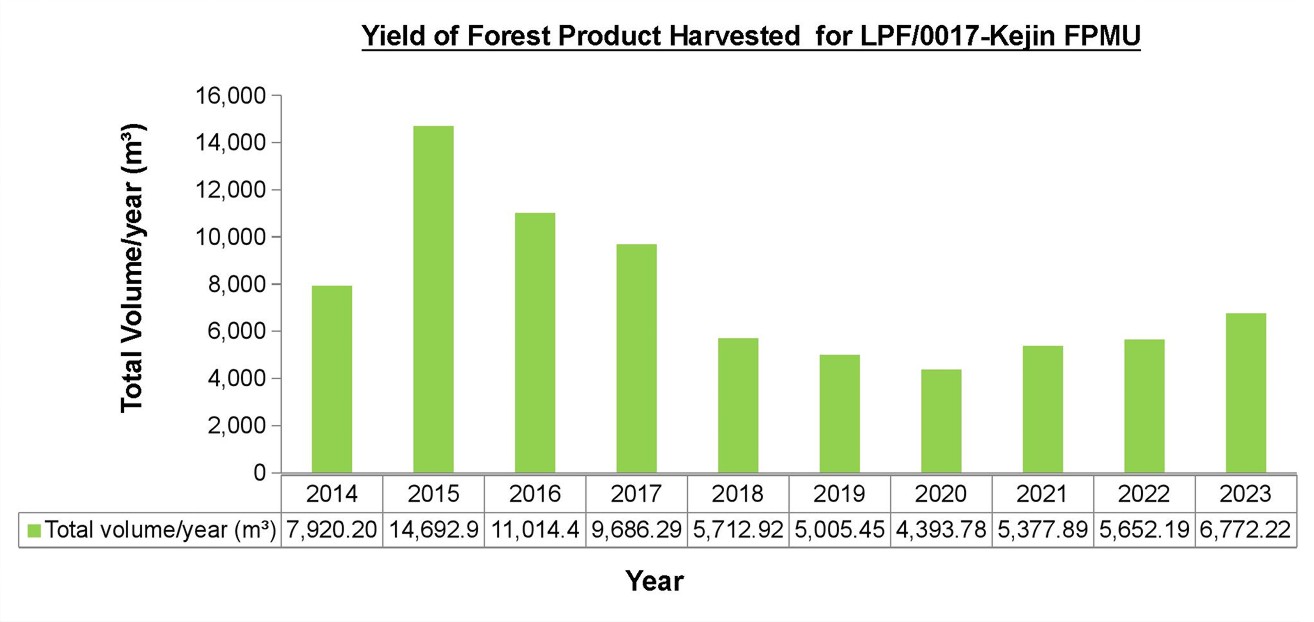 Figure 3.0: Yield of forest product harvested LPF/0017 Kejin FPMU
Figure 3.0: Yield of forest product harvested LPF/0017 Kejin FPMU
16.2 Growth Rates Of The Planted Forest
BBased on data collected from the established PSPs, the average MAI for P. falcataria was 7.63m³/ha, meanwhile for A. mangium was 10.30m³/ha.
16.3 Composition And Observed Changes In The Flora And Fauna
16.3.1 Flora
The undisturbed forest within the FPMU is confined to buffer zones, wildlife corridors, and protected areas, which remain intact and conserved. These protected areas remain intact and well-conserved, reflecting effective conservation efforts. However, no further study on flora changes has been conducted due to a lack of expertise.
16.3.2 Fauna
The fauna species has been identified by our Surveyor during forest patrolling through direct observations, and indirect methods (e.g: foot prints, dung, etc). Some of the species cannot be identify due to lack of expertise.
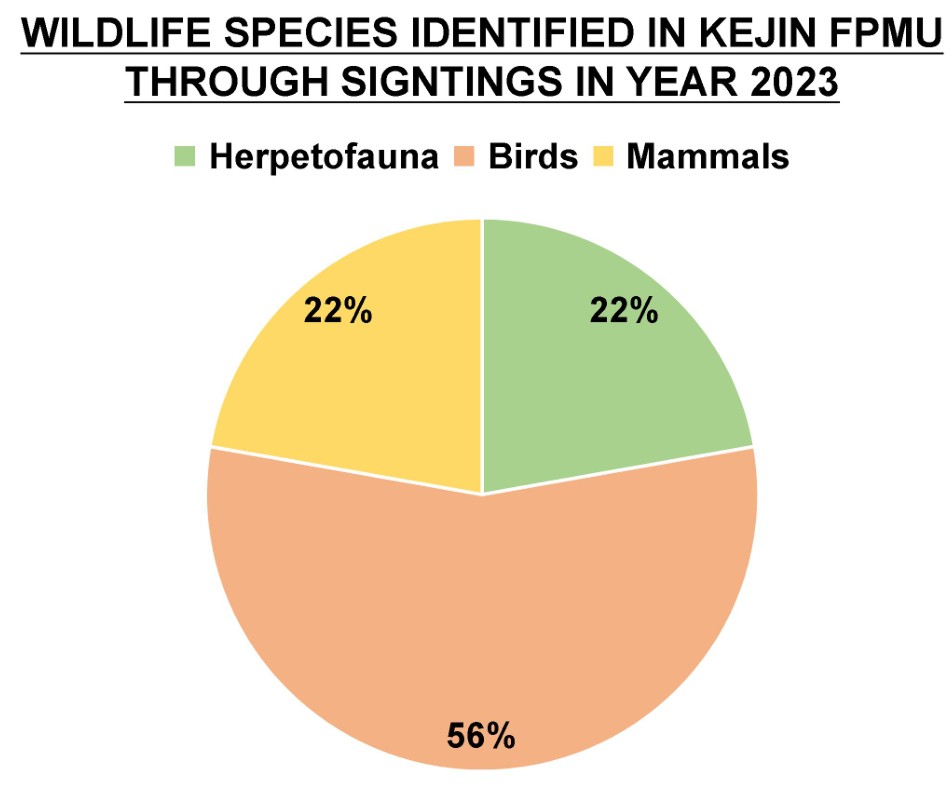 Figure 4.0: Percentage of Fauna Species identified in LPF0017 Kejin FPMU in Year 2023
Figure 4.0: Percentage of Fauna Species identified in LPF0017 Kejin FPMU in Year 2023
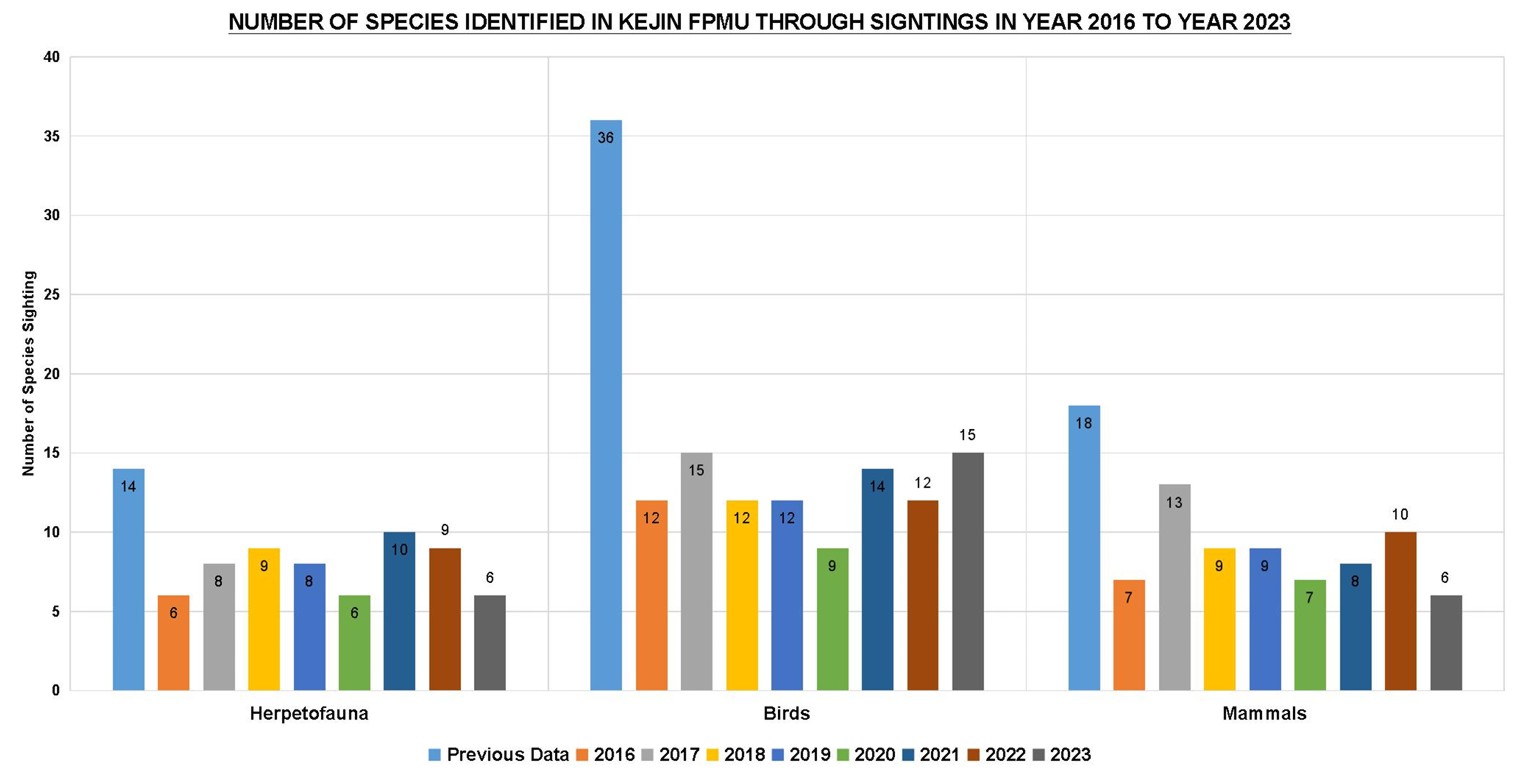 Figure 5.0: Number of species identified in LPF0017 Kejin FPMU through sightings
Figure 5.0: Number of species identified in LPF0017 Kejin FPMU through sightings
16.4 Environmental And Social Impacts Of Harvesting And Other Operation
16.4.1 Environmental impacts
Based on the year 2023 of the EMR (EMR reference No.: NREB/6-3/2H/5), the results of the water quality analyses at SLL1 and SLL4 are tabulated in Table 4.0:
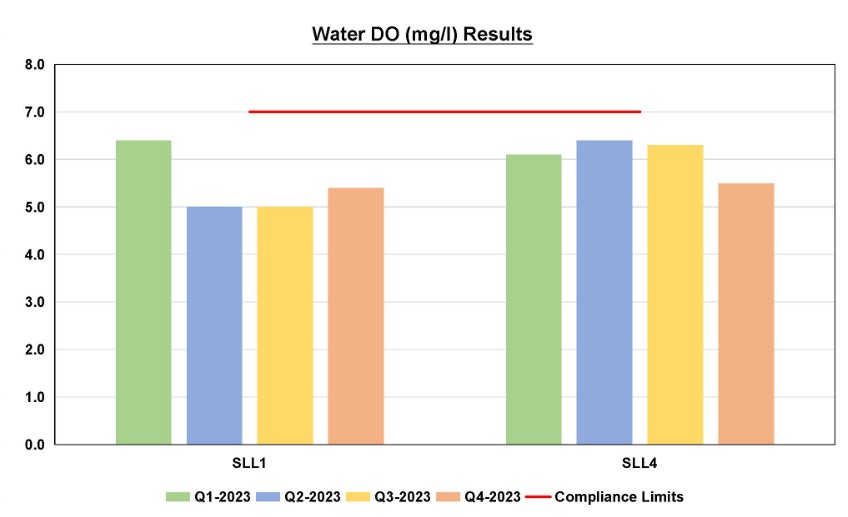
Figure 7.0: Water DO (mg/l) Results
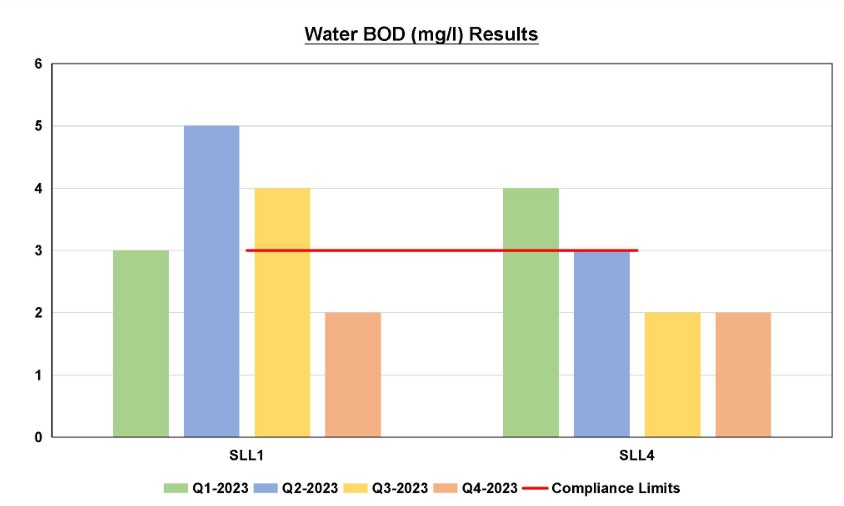
Figure 8.0: Water BOD (mg/l) Results
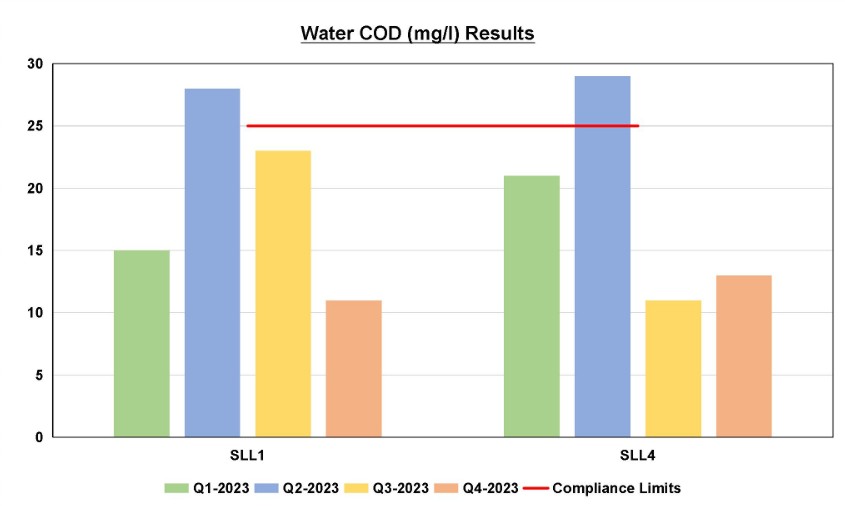
Figure 9.0: Water COD (mg/l) Results
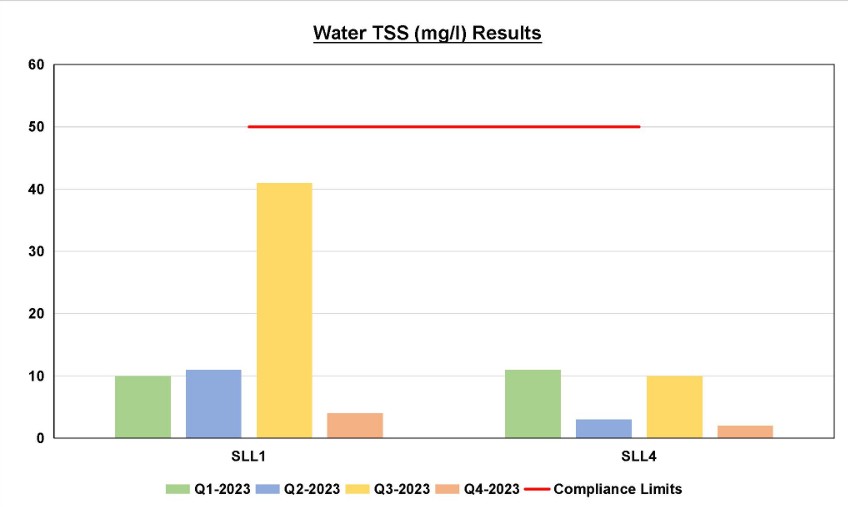
Figure 10.0: Water TSS (mg/l) Results
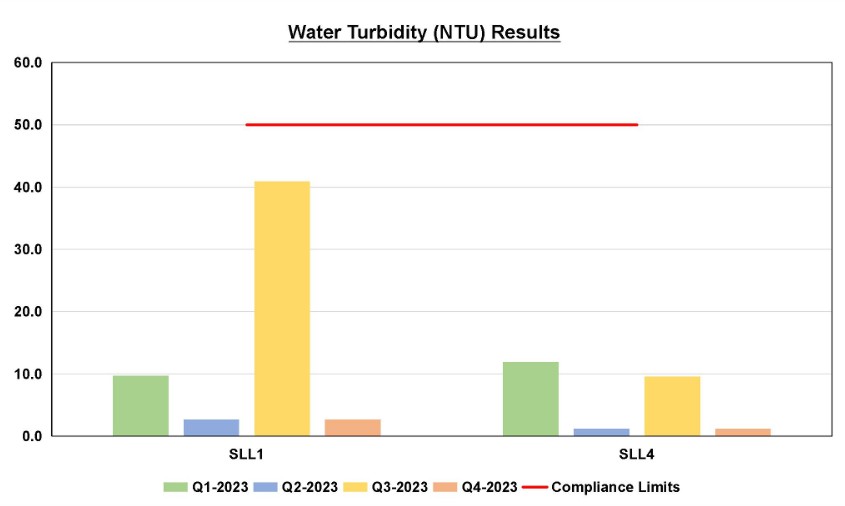
Figure 11.0: Water Turbidity (NTU) Results
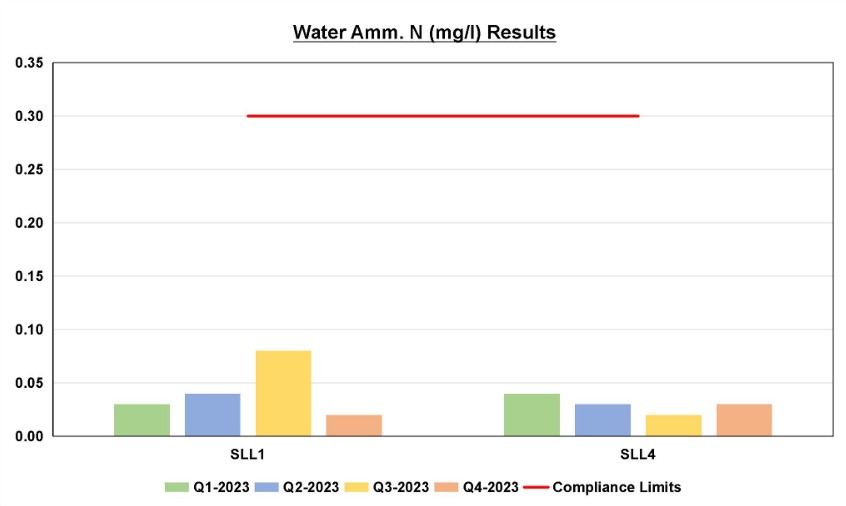
Figure 12.0: Water Amm. N (mg/l) Results
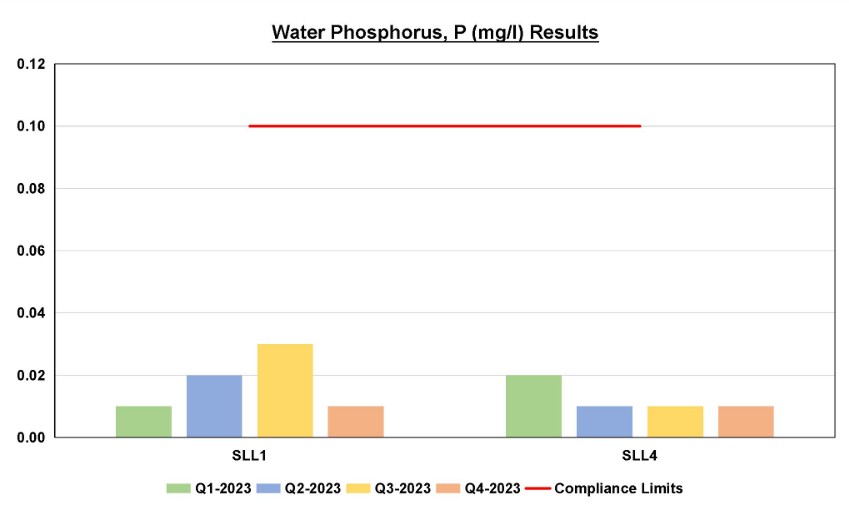
Figure 13.0: Water Phosphorus, P (mg/l) Results
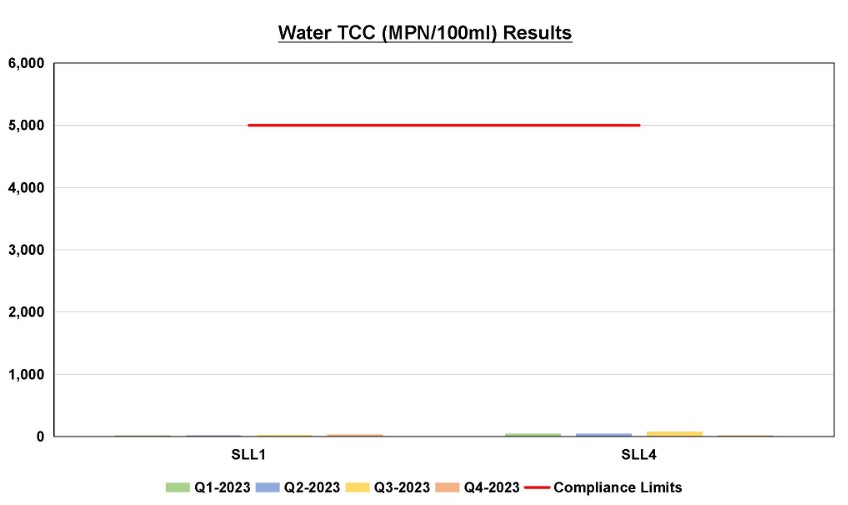
Figure 14.0: Water TCC (MPN/100ml) Results
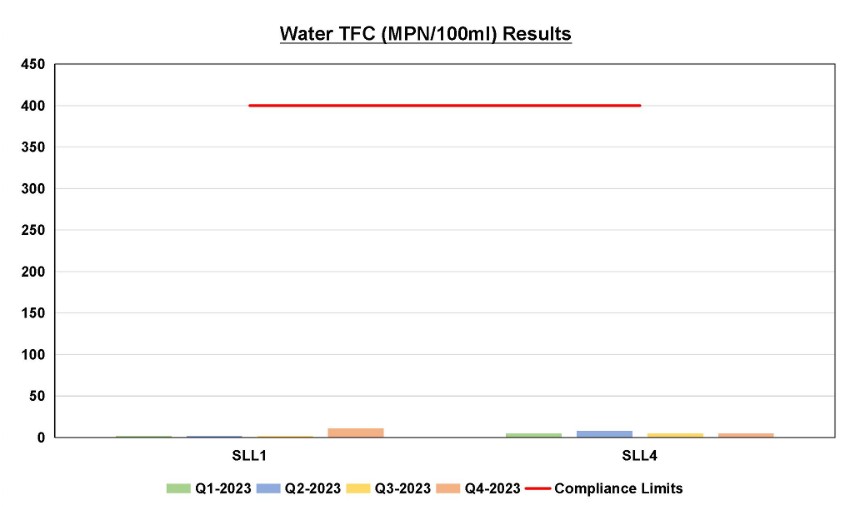
Figure 15.0: Water TFC (PMN/100ml) Results
Biodiversity Conservation and Retention of Buffer Zone
The major drainage systems in the Plantation were in place. Sufficient riparian buffers with vegetation had been set aside along the major waterways such as along Sg. Temala, Sg. Palutan and Batang Baram.
Domestic Waste Management
Sanitary toilets with septic tank facilities had been provided. The domestic wastes generated at the workers’ camps are collected and dumped in a pit within the Plantation
Workers Health and Safety
No major communicable or vector-borne disease or major occupational accidents had been detected or reported.
Pest and Disease Management
Pest and disease are not a serious problem in the Long Lama Estate Plantation
16.4.2 Social impacts
Since 2014, there have been no complaints, land disputes, or conflicts between local communities and the FPMU, and no activities have occurred in areas liable to NCR claims. The FPMU has allocated 10,952 hectares for Shifting Agriculture (SA) use by local communities and prioritizes employment for locals from areas such as Long Lama and Baram. In 2023, the FPMU employed 18 staff members and 16 general workers, all residing in provided quarters, and has actively increased recruitment from local communities through direct communication and job postings on longhouse notice boards. As of 2023, SYF has contributed approximately RM215,421.70 to CSR activities, which include transportation (shuttle services and event transport), food assistance (distribution during funerals and aid to fire victims), basic amenities (clean water, generators), periodic contributions (financial support for various celebrations), education (donations to schools), housing materials (support for construction projects), machinery (for community and agricultural use), and infrastructure development (maintenance of roads, culverts, and bridges).
16.5 High Conservation Value Areas monitoring result
LPF0017 LONG LAMA KEJIN FPMU HCV MANAGEMENT AND MONITOR SUMMARY
16.6 Cost and productivity of forest management
Cost and productivity of the company’s operation was confidential. Please refer to the management for details and information.
17. LIAISON COMMITTEE
Liaison committee responsibility is as below:
-
Issues over tenure claims and use rights.
-
Conflicts pertaining to the recognition of the legal and customary rights of the local communities.
-
Measures threaten or diminish resources or tenure rights of the local communities.
-
Protected the sites with special cultural, ecological, economic or religious significance to the local people.
-
Long term social and economic well-being of forest workers and local communities.
-
Grievances and provide fair compensation in case of loss or damage affecting the legal customary rights or livelihoods of local people.
-
The use of the forests’ multiple products and services to ensure economic viability with the environmental and social benefits.
-
Carry out annual consultation to maintain the long-term social and economic well-being of local communities
18. COLLABORATIONS & RESEARCH
Some studies will be parts of our research activities in this tree plantation project. Shin Yang Forestry Sdn Bhd with collaboration of Sarawak Forestry Corporation (SFC) and University Putra Malaysia (UPM) under MoU signed in 2012. Further research will be carried out for technical development of tropical tree plantation. The planned studies are as follows:
-
Silviculture scheme and yield
-
To determine the best harvesting time
-
Biological disease control without agrochemicals
Other items in MoU:
-
Permanent Sample Plot management
-
Biological control and protection
-
Study on carbon foot print
-
Research and Development on Nursery, Tree Plantation and Reforestation
-
Nursery practice and planted forest establishment
-
Plant propagation techniques
-
Biological control and protection
19. BUDGETARY
Annual budget includes the expenses of overall operations and activities namely; Nursery, Land preparation, Planting & Supply, Silviculture, Harvesting, Conservation & Monitoring, Transport & Infrastructure including social program, Amenities for workers, Safety, Staff training, research development etc.
20. COMMUNITY’S ISSUE RESOLVING
Any conflict and grievances between local community and company will be resolved according to Mechanisms to Resolve Local Community Issues (SYF / MC & I / P.09) by following the relevant laws (either federal or state laws) as below:
- Federal Constitution – Article 8 and 13
- Land Code (Cap. 81) – Section 5 and 6
- Human Right Commission of Malaysia Act, 1999
- All adat codified under the Native customs (Declaration) Ordinance, 1996, and any other adat recognised and enforceable by the Native Courts under the Native Courts Ordinance, 1992, and the Native Courts Rules, 1993
- Decisions of the Civil Courts pertaining to legal or customary tenure or use rights
Grievance procedure process flow Figure 3.0: Grievance procedure process flow
Figure 3.0: Grievance procedure process flow
- END -






